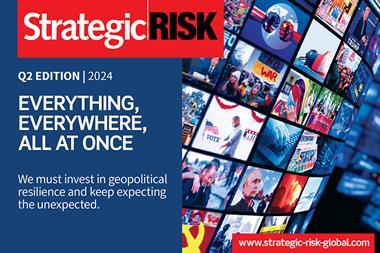Climate change is so big that we do not even see it as a wave that may “break” and cause havoc for us
COVID-19 is still rampaging the world and second wave infections are underway in many countries. At the same time, we are beginning to see the vaccines emerging and mass vaccination programs are being prepared, at least in countries wealthy enough to establish these.
We are at the end of the beginning, and on the path towards a new normal. This may not be one, where COVID-19 does not exist, but one, where this can be managed as we can treat this. However, many people will not have the affluence, nor the access to benefit from this, and at present it is unknown how long the pandemic will be an issue we need to address.
However, there will come a time after COVID-19. A time, where many elements of management and risk management needs to differ from past practices to be even remotely relevant and value adding.
Post COVID-19 risk management
Companies are actively addressing the prudence of global interconnected supply chains, the opportunities of working from home, the next level use of online trading and communication, etc. There is little doubt business systems and market dynamics have been changed for the good by the disruption emerging from the pandemic.
Risk managers need to be in the forefront of this, or risk being left behind. Issues to address from a risk and opportunity perspective will include:
- Our market and market dynamics have changed
- Our business system has already or will be changed
- Our approach to workplace has changed
- Our organisational structure may very well change
Which new risks and opportunities do these changes invoke, and which past risks and opportunities are no longer relevant?
Even risk managers who focus on risk minimisation and rely on qualitative low/medium/high scores and heatmaps will see significant changes from the heatmap of 2019 to that of 2021.
This is an immediate concern as competitors have already started changing their approaches, ways of doing business and market focus and new competitors emerge.
Where many companies have been used to a strategic horizon of three to five years or longer, the world now forces us to make significant strategic choices to be set in motion over the next 12-18 months.
The current level of turmoil will also lead executives to be more open to soliciting and receiving advice than what may have been the case under ’normal’ circumstances. Risk managers have an opportunity to step up and provide real advice and support to address uncertainties intelligently.
So – risk managers. This is your window of opportunity to step up and add true value to your company, beyond buying an insurance and establishing some compliance procedure. Such elements may be valuable enough – but more is needed now.
The next wave
The next wave, I predict, is not a new wave we have never seen before, but one which is all around us already. The wave of climate change. In fact, it is so big, we do not even see it as a wave that may “break” and cause havoc for us.
Listening to the UN Secretary-General António Guterres in his recent State of the Planet address, the human race is currently racing down the wrong path in a “war against nature”. But, as he states in the address – nature always fights back, and nature always wins.
- Ice is melting and global temperatures are rising
- Wildfires in California and Australia are at unprecedented levels
- Hurricanes are becoming more frequent and intense
- COVID-19 is a consequence of human impact on the natural environment
The list is long, and Secretary Guterres lists a number of examples. Among these he states that current projections of global warming indicate a 3-5 degree rise in temperature by the end of the century, rather than the 1.5 degree targeted by the Paris Agreement.
Obviously, the world is already experiencing nature fighting back, and these examples can no longer be considered as extremes or anomalies. The next level of natural disasters will be bigger than anything we have ever seen before – and the next one after that, bigger again.
Oxford University Professor Bent Flyvbjerg talks about this as “regression to the tail”.
The immediate question for any astute risk manager is now, “How will this affect our organisation and its stakeholders in terms of…”
- Our market and market dynamics?
- Our supply/value chain and business system?
- Aspirations and target setting?
Using a more active approach, the questions can be altered to:
- How do we measure success and failure in the ’new world’?
- What are our unique capabilities, and how can these be brought into play?
- Which markets do we cater to, and which do we leave?
- How do we establish competitive advantages?
- How do we build/rebuild our supply/value chain?
- How do we organise?
Some of these issues may be long term and not with any major change within the first three to five years. However, large transformations are often recognised by the fact that “to begin with, nothing happens” and tenacity and commitment is needed to prevail.
A moonshot moment
As a risk manager, you cannot possibly see climate change as a ’Black Swan’ which you can then excuse yourself by once the calamity hits. This is a ‘grey rhino’ which is charging towards you and will be dangerous if you do not act in a timely manner.
Some companies will see a need for significant transformation – one, which cannot be implemented in terms of a few years. To make such transformations in time, something may very well have to happen ‘next week’.
In many instances, it is like when John F. Kennedy in 1963 stated that the United States would put a man on the Moon by the end of the decade. It was still seven years into the future, but NASA immediately realised, that to meet that target, they needed to be able to do this and that by 1968, that by 1967 and so forth, and … we need this ready 6 months from now.
I trust a lot of risk managers have already stepped up, and are in full process of addressing this. Those that are not have a small window of opportunity. The longer you wait, the less you and your company can accomplish in terms of being competitive and relevant and prosperous ten or 20 years time.
You need to address these issues now. If human beings do not globally change course – and alas, I see too little evidence of real action to that effect – global warming will increase, water levels will rise, storms, droughts, wildfires and floods will get worse.
When the next extreme event impacts a megacity it will be too late for the risk manager to think, “now, what do we do?”
You may be just one risk manager in one company, but you can:
- Push your company to take active part in solving the problem rather than worsening it;
- Push your management to establish performance metrics which are conducive of good environmental behaviour rather than focused on short term fiscal gains;
- Prepare your company in time for those consequences of climate that are especially relevant for you, and
- Collaborate with your HR team to ensure your company is attractive to relevant talent to maintain its future fitness.
Risk management is an approach to support creating and protecting value. With the next wave of climate change raging upon us at an ever-increasing speed and volume – this becomes a truly strategic matter of survival.
Survival, if not of the human race, then at least of your company in a world grossly and increasingly affected by climate extremes.
As we come to the end of 2020, it is clear the world is an increasingly challenging place. On top of climate change we have a range of parallel issues, many of them interlinked:
- The 4th industrial revolution with disruptions invoked by technological advances
- Wealth distribution and inequalities
- Political conflicts
- Over-population/food crises
- Refugees/migration
Professionally, there is plenty to do for a risk manager. Every company will be affected by several of these issues. The foundation is “trouble”, the solution is “opportunity” and the strategy is “tenacity”.
Step up, earn your title and be a valuable partner in your company.
Hans Læssøe is founder of AKTUS




















No comments yet